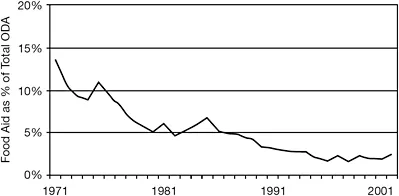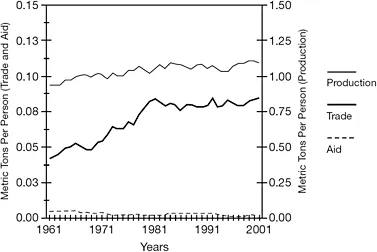
eBook - ePub
Food Aid After Fifty Years
Recasting its Role
Christopher B. Barrett, Dan Maxwell
This is a test
- 336 Seiten
- English
- ePUB (handyfreundlich)
- Über iOS und Android verfügbar
eBook - ePub
Food Aid After Fifty Years
Recasting its Role
Christopher B. Barrett, Dan Maxwell
Angaben zum Buch
Buchvorschau
Inhaltsverzeichnis
Quellenangaben
Über dieses Buch
This book analyzes the impact food aid programmes have had over the past fifty years, assessing the current situation as well as future prospects. Issues such as political expediency, the impact of international trade and exchange rates are put under the microscope to provide the reader with a greater understanding of this important subject matter.This book will prove vital to students of development economics and development studies and those working in the field.
Häufig gestellte Fragen
Wie kann ich mein Abo kündigen?
Gehe einfach zum Kontobereich in den Einstellungen und klicke auf „Abo kündigen“ – ganz einfach. Nachdem du gekündigt hast, bleibt deine Mitgliedschaft für den verbleibenden Abozeitraum, den du bereits bezahlt hast, aktiv. Mehr Informationen hier.
(Wie) Kann ich Bücher herunterladen?
Derzeit stehen all unsere auf Mobilgeräte reagierenden ePub-Bücher zum Download über die App zur Verfügung. Die meisten unserer PDFs stehen ebenfalls zum Download bereit; wir arbeiten daran, auch die übrigen PDFs zum Download anzubieten, bei denen dies aktuell noch nicht möglich ist. Weitere Informationen hier.
Welcher Unterschied besteht bei den Preisen zwischen den Aboplänen?
Mit beiden Aboplänen erhältst du vollen Zugang zur Bibliothek und allen Funktionen von Perlego. Die einzigen Unterschiede bestehen im Preis und dem Abozeitraum: Mit dem Jahresabo sparst du auf 12 Monate gerechnet im Vergleich zum Monatsabo rund 30 %.
Was ist Perlego?
Wir sind ein Online-Abodienst für Lehrbücher, bei dem du für weniger als den Preis eines einzelnen Buches pro Monat Zugang zu einer ganzen Online-Bibliothek erhältst. Mit über 1 Million Büchern zu über 1.000 verschiedenen Themen haben wir bestimmt alles, was du brauchst! Weitere Informationen hier.
Unterstützt Perlego Text-zu-Sprache?
Achte auf das Symbol zum Vorlesen in deinem nächsten Buch, um zu sehen, ob du es dir auch anhören kannst. Bei diesem Tool wird dir Text laut vorgelesen, wobei der Text beim Vorlesen auch grafisch hervorgehoben wird. Du kannst das Vorlesen jederzeit anhalten, beschleunigen und verlangsamen. Weitere Informationen hier.
Ist Food Aid After Fifty Years als Online-PDF/ePub verfügbar?
Ja, du hast Zugang zu Food Aid After Fifty Years von Christopher B. Barrett, Dan Maxwell im PDF- und/oder ePub-Format sowie zu anderen beliebten Büchern aus Business & Business General. Aus unserem Katalog stehen dir über 1 Million Bücher zur Verfügung.
Information
1
The basics of food aid
As with much of the development business, food aid practitioners employ a bewildering array of opaque terms and peculiar acronyms that can make it a bit difficult for outsiders to comprehend even the broad contours, much less the details, of conceptual, policy and operational debates. This brief chapter, supplemented by the Glossary at the end of the book, aims to introduce the basic concepts, terminology, and patterns that must be understood prior to serious reflection on the role and design of an effective food aid strategy.
The misunderstanding of food aid begins with an ongoing, basic definitional issue.1 The term “food aid” is commonly, but inaccurately, used to refer to the donation of food to recipient individuals and households. By this standard, Americans would be among the world’s most numerous food aid recipients because of the extent of the school feeding in the United States, temporary assistance to needy families, food stamps, and other “food assistance programs.”2 Indeed, even private donations for neighborhood feeding programs – including such common activities as parental programs to provide mid-morning snacks to school children3 – would qualify as “food aid” under such a broad definition, underscoring how such an expansive definition quickly loses its usefulness. The defining feature of food aid relates neither to the identity of final recipients, who may or may not need additional food beyond that they can produce or procure on their own, nor to the form of transfer. As we will discuss, much food aid gets turned into cash by nongovernmental organizations (NGOs) or private voluntary organizations (PVOs) and governments and therefore is not distributed as food to hungry people, while “food aid” can likewise take the form of cash donations used to purchase foods in surplus regions of the recipient country for distribution elsewhere. Rather, three core characteristics distinguish food aid from other forms of assistance:
(1) the international sourcing
(2) of concessional resources
(3) in the form of or for the provision of food.
Without some cross-border flow of food or cash for the purchase of food and without there being a significant grant element, the flow is simply not food aid. Food aid is thus as much an issue of procurement as one of distribution, and it is most fundamentally an entry into nations’ balance of payments. Food transfers that do not have corresponding balance of payments entries – such as school feeding programs in the United States, European prenatal nutrition programs, and food subsidies in much of the world – are not internationally sourced, they do not involve donations from another country. Such programs are not food aid even though they involve assistance related to food. Similarly, commercial international trade in food fails to meet the concessional element of the definition because there is no donation involved. Finally, international flows of financial aid that are unrelated to food (e.g., for military equipment or technical assistance) obviously do not qualify as food aid.
Modest flows intended to make a big difference at the margin
Food aid’s visibility during crises masks a meagerness that many observers do not fully appreciate. While food aid was once a central part of overseas development assistance (ODA) provided by wealthier countries to poorer ones,4 since 1995 it has averaged less than 2 percent of ODA (Figure 1.1). Not only is food aid a small portion of total foreign aid flows, it pales in comparison to domestic production and commercial trade flows as a source of food. Figure 1.2 underscores how food production and commercial food trade dwarf food aid flows today.5 (Notice that production is measured against the right-hand axis, which is ten times larger than the left-hand axis against which aid and trade flows are measured!) While commercial food trade flows have grown steadily over time, accelerating especially sharply in the 1960s and 1970s, with slower growth in food trade thereafter, food aid flows have fallen by about two-thirds, averaging only 2 percent of food trade flows, from 1995–2000, and 0.15 percent of food production volumes over that period.6 Even food aid flows to the poorest countries have halved in per capita terms since 1992.7
Globally, the volume of food aid is too limited to supplant production or trade as a source of food other than for very brief periods in very localized situations. Rather, the humanitarian objective of food aid is to make a big difference at the margin by relieving shortfalls in food availability that contribute directly to widespread, often acute hunger, malnutrition, and undernutrition, shortfalls that local markets cannot fully correct if poor people are just provided cash.8
Enough food is produced globally to meet every person’s dietary requirements adequately. In 2000, the world enjoyed a daily per capita supply of more than 2,800 kilocalories and 75 grams of protein, more than enough to keep every man, woman, and child well nourished.9 Such ample global food supplies are a relatively recent phenomenon. In 1961, the equivalent figures were only 2,256 kilocalories and 62 grams of protein daily per capita. The world has enjoyed an increase in daily average nutrient supply per person of 21–24 percent in just forty years, an historically unprecedented achievement. The technological advances in agricultural productivity that brought about such growth have resolved the global food aggregate supply problem, at least for current generations.

Figure 1.1 The decline of food aid within ODA
Source: OECD/DAC

Figure 1.2 Global annual food flows
Source: OECD/DAC
In spite of this global plenitude, the most recent estimates of the Food and Agriculture Organization of the United Nations (FAO) suggest that roughly 852 million people – more than one person in eight worldwide – do not get enough to eat.10 Many more than that are at risk of having insufficient access to food to maintain good health at intermittent points in time. The aggregate global food availability figures mask tremendous discrepancies among individuals and communities around the world, both within and between countries. Inequitable distribution within countries, within communities and even within households, is distressingly high. For example, the most recent data show that one in ten households in the United States – the country with the greatest per person food supplies in the world – experiences hunger or the risk of hunger.11 Such intra-national variation is the subject of domestic policy, especially with respect to food assistance programs such as food stamps, food subsidies, school feeding programs, food price stabilization policies and the like.12 While we recognize and are concerned about discrepancies in equitable food distribution at all these levels, the broader challenge of alleviating hunger and undernutrition globally lie beyond the scope of this book.
International food policy must address sharp discrepancies between countries in food availability. An expert consultation convened by the FAO established a daily caloric intake minimum of 2,350 per person as a goal.13 Yet even in terms of average national consumption, a very rough indicator of food security, FAO food balance sheet data14 suggest that about sixty countries fall below this threshold. Roughly two-thirds of these are in Sub-Saharan Africa. While the roughly 280 million people in the United States enjoyed daily supplies per person of 3,772 calories and 114 grams of protein in 2000 – up 30 and 20 percent, respectively, from 1961 – the equivalent figures for Sub-Saharan Africa’s more than 600 million people were only 2,226 calories and 54 grams of protein – up only 6 and 3 percent, respectively, since 1961. Stagnant productivity per capita and limited hard currency earnings with which to import food generate large-scale food availability shortfalls in much of the world. Food deficiencies at national and even continental scales in a world of global surpluses underscore that the contemporary food security challenge is partly a problem of stimulating agricultural productivity in some poorer ...